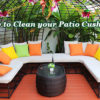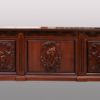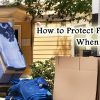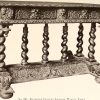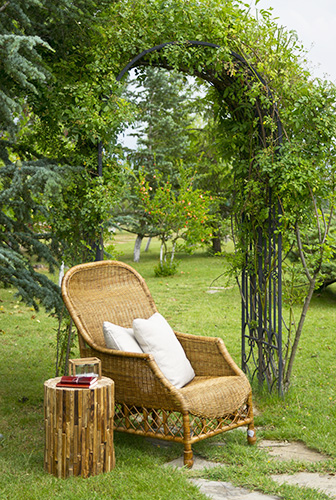
Patio cushions add a lot of comfort and beauty to the outdoor space.
Outdoor cushions and pillows add comfort and beauty to patio furniture and enhance the delight of spending time on the porch, in the backyard, or any other outside area of the home. They’re easy to maintain and come in a wide array of colors, textures, and designs to suit any taste and occasion. The colorfast fabrics woven with solution-dyed acrylic fibers are extremely durable, very attractive, and quite pleasant to the touch.
After several months of use and abuse during the spring and summer, however, patio cushions may have taken quite a beating, especially if they’ve been sitting out in the elements unprotected – rainstorms, fogs, and wet weather may have caused mold to grow on the fabric; bird droppings and tree sap may have stained the surface; dust and dirt may have accumulated over time and made the uphosltery look dull and dingy, etc. Outdoor furniture cushions could really use a thorough cleaning after the end of the summer season.
So, as autumn advances and you’re preparing to store your patio cushions for the cold weather, be sure to give them a good scrub down first – cleaning the pillows after a season of use will keep the dirt from setting in, prolong the life of the cushions, and make spring time preparation much easier.
Here are some useful guidelines on how to clean outdoor cushions that will help you complete the job in a quick and effective manner:
What Is the Best Way to Clean Outdoor Cushions?
Cleaning patio cushions is cheap and easy – it does not take long and does not require any specialized cleaning supplies or too much elbow grease.
Outdoor furniture upholstery and pillows are usually made of treated fabrics – anything from natural materials like canvas to synthetic materials like vinyl or polyester – that resist sun damage and repel stains. On the inside, patio cushions consist of polyester fiber or reticulated foam that allows water to pass through quickly. Therefore, outdoor pillows are quite durable and easy to maintain. With proper care they will look and feel good for many years.
So, when the time comes to prepare your outdoor furniture for the winter, make sure you clean the patio cushions well to keep them in excellent condition for the next season:
- Read the labels to find out what type of fabric and filling contents you’re dealing with – some cushions may be machine washable, while others are not; some cleaners may be harmful to certain fabrics and should be avoided; some materials may have been treated with special coatings for better protection against UV rays and water; etc. It is, therefore, very important to check the cleaning guidelines on the cushion tags for specific cleaning instructions and restrictions (if the cleaning tags are missing, check the manufacturer’s website for that information);
- Brush off dust and debris – Shake the cushions or use a stiff-bristled brush to scrub away any excess dirt (scrub gently so that you don’t accidentally damage the fabric);
- Slip off removable covers (when applicable) – Some cushion covers cannot be removed, while others are secured with zippers or fabric fasteners. If your outdoor pillows are designed with removable covers, slip off the cases and wash them separately (see below for details);

Find out what kind of fabric and filling your outdoor cushions have so that you know what cleaning agents and techniques will be right for the pillows.
- Vacuum clean the cushions – Remove any loose dirt and dust from the pillows using the upholstery attachment on your vacuum. If your cushions are tufted, be sure to run the attachment carefully over any crevices, seams, and buttons;
- Wash the cushions with a soapy solution and let them air-dry (see below for details);
- Apply a fabric protector – When the cushions are completely dry, spray them with a fabric protector to help them resist moisture, dirt, and stains (a quality spray-on fabric protectant acts as a water and stain repellent).
How to Wash Outdoor Cushions and Cushion Covers
Machine washing is your easiest option for items that can safely go in the washer – once you’ve removed loose dirt and debris from the cushions, you can just throw them in the washing machine. Be sure to read all the instructions listed on the cleaning tags and follow any specific washing recommendations for your pillows. Unless otherwise specified, wash the cushions on gentle cycle, using a mild detergent and cool water. Allow the pieces to air dry completely before returning them to the furniture or storing them away.
If your cushions have removable covers, unzip the cases and wash them separately – either by hand or in a washing machine:
- To machine wash slipcovers, set water temperature on cool and use a mild laundry detergent. You may add 1 cup of chlorine bleach to the load if the covers are heavily stained or show signs of mold growth. Do not place the fabric in a hot dryer because that may cause shrinkage. Let the covers air dry for some time, then place them back on the cushions while still slightly damp so the material gets back into shape. Use a cool to medium iron to smooth wrinkles if needed;
- To wash removable covers by hand, mix a quarter cup of liquid detergent with a gallon of lukewarm water, let the fabric soak for about 15 minutes, and wash intensively. Rinse well and allow the covers to air dry for a while. Place them back over the inserts before they’re completely dry so they don’t shrink or lose their shape.
How to Clean Patio Cushions
Choose a nice, sunny autumn day to clean your outdoor cushions and get to work in the morning, so that the fabric has a chance to dry in the warm afternoon hours.
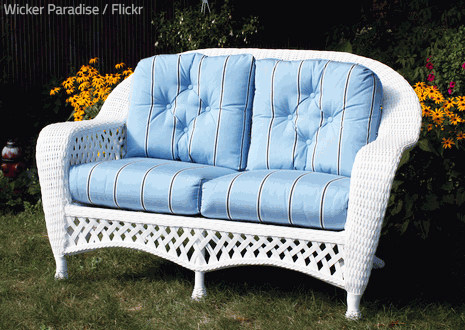
A perfect day for cleaning your outdoor furniture cushions.
- Spread the pillows out on a plastic tarp (after they’ve been vacuumed up and any removable covers have been slipped off);
- Mix ¼ cup of dishwashing liquid with 1 gallon of lukewarm water (you may add ¼ cup of Borax to the mixture as well). Stir until the solution gets sudsy;
- Work the bubbles into the fabric with a sponge. Generously saturate both sides of the cushions and be sure to get into all grooves and crevices;
- Let the solution soak for about 15 minutes;
- Scrub the cushions from top to bottom with a soft bristle brush – scrub gently, working on a small section at a time;
- Rinse thoroughly with the garden hose and spray nozzle;
- Press on the cushions to remove excess water;
- Wrap a towel around each pillow to blot up most of the remaining water;
- Stand the cushions on edge to air dry (either take the pillows to dry in a shady area or flip them every couple of hours to alternate the side that gets direct sunlight). Keep in mind that it may take a couple of days for thick items to dry completely.
Make sure your cushions are fully dry before you store them for the winter (use the blow drier if necessary) to prevent mildew. It’s a good idea to spray them with a fabric protector as well.
How to Remove Stains from Outdoor Cushions
Now that you know how to clean outdoor furniture cushions in general, you may be worried about persistent stains.
Patio cushions can get stained from grass, tree sap, bird droppings, food and beverages, sunscreen, etc. Mildew stains are also very common as outdoor pillows stay out in wet weather and often get soaked by unexpected showers, morning dew, etc.
It’s important to treat stains immediately after they occur (or at least, as soon as you notice them), as the longer a stain sits, the deeper it will penetrate into the fabric fibers and the more difficult it will be to remove.
The best way to remove a stain depends on the type of stain you’re dealing with:
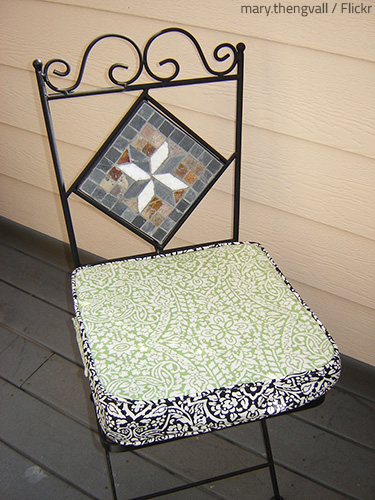
A stain among the intricate patterns will look quite out of place, don’t you think?
- How to remove grass stains – Use a heavy duty liquid detergent with stain removing enzymes – work it into the stained area with a soft brush, let it stand for a awhile, scrub gently, then rinse with clear water. Soak the cushion in a solution of warm water and oxygen-based bleach for at least one hour, wash the entire piece, and spray it down with a garden hose;
- How to remove tree sap stains – Treat the spot with a stain remover, then apply a paste made of powdered detergent and water and let it sit for about half an hour. Scrub the stain lightly and rinse with hot water. Next, wash the cushion in hot water, using detergent and oxygen bleach;
- How to remove bird droppings – Remove as much of the droppings as possible with a microfiber cloth, then spray the stain with a solution of 1 teaspoon mild dish soap, 1 teaspoon Borax, and 1 quart of warm water mixed in a spray bottle. Let it soak for 15 minutes, scrub with a soft bristle brush, and rinse well with clean water;
- How to remove oil stains (from sunscreens, bug sprays, or food) – Soak up any excess oil with a cloth and apply some cornstarch (or other absorbent powder) to the stain. Allow it to sit for 15 minutes, then scrape the powder away with a straight edge and wash the stain with a soapy cleaning solution. Rinse thoroughly with a clean, damp microfiber cloth. If the stain doesn’t go away, make a paste of powder detergent and water, apply it on the spot and let it sit overnight. Then wash the piece as described above;
- How to remove wine stains and juice stains – Blot up as much of the liquid as possible, then sponge the stain with a solution of two cups cool water and one tablespoon dishwashing liquid. Blot at the stain again until it is gone, clean off the soapy solution with sponge and cold water, and blot dry;
- How to remove mildew from patio furniture cushions – Add ½ cup oxygen bleach and ¼ cup mild detergent to a gallon of water. Apply the mixture to all areas of the cushion that are showing signs of mold or mildew. Leave it on for about 20 minutes, scrub with a soft bristle brush, and rinse thoroughly.
Good to remember: Most treated fabrics that are suitable for outdoor cushions can handle a diluted bleach solution, but it’s important to do a spot test before using bleach on colored fabric. Apply the mixture on a small, inconspicuous spot first to make sure that it won’t cause any fading or damage to the fabric. Use bleach sparingly and only when stains do not respond to milder treatments.
If the material cannot handle bleach, mix one part distilled white vinegar or hydrogen peroxide and one part water in a spray bottle. Spray directly on the mildew stains, wait for about 10-15 minutes and scrub with a soft-bristled brush. Rinse with clean water and let the piece air dry.
If you notice a stain when cleaning your patio furniture cushions for storage, be sure to pre-treat the stained area (as detailed above) before washing the piece.
How to Keep Patio Cushions Clean and Looking Good at All Times
Cleaning outdoor cushions in the fall will be much easier if you maintain them properly during the spring and summer months. Besides, regular cleaning will not only make your job simpler, but will also ensure that your pillows look great at any time. So, make sure you:
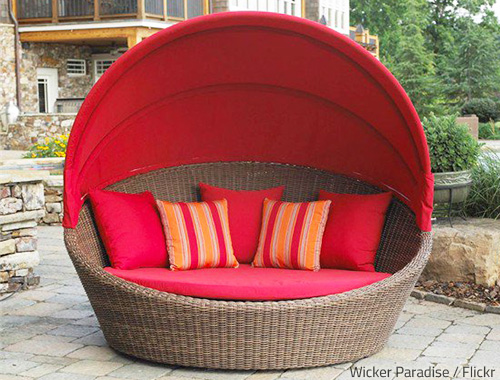
Inviting, isn’t it?
- Brush off the cushions often to prevent dirt and dust buildup. Use a whisk broom or vacuum with the upholstery attachment to remove dust, dirt, insects, and plant debris from the fabric. Pay special attention to the seams and any little grooves or creases, as they gather more dirt and are more likely to develop mold growth;
- Wipe away fallen leaves every day to prevent them from turning to mulch and leaving unsightly stains;
- Rotate and flip cushions so that they get even amounts of sunlight;
- Take pillows inside when storms and torrential rains are expected to hit your area;
- Turn cushions on edge when they get soaked by an unexpected shower to speed up drying time;
- Protect cushions with water sealants and fabric protectors;
- Spot clean instantly as stains occur – For liquid spills, use a clean, dry microfiber cloth to blot the wet spot. Do not rub the stain as rubbing will push it further into the fibers and will make it harder to remove. Spray the stain with a solution of 4 cups water, 1 teaspoon mild dishwashing liquid, and 1 tablespoon of borax, blot again, then rinse with cool water. It’s best to wash the entire cushion, not just the stained area, to avoid water stains. See above for more information on how to treat specific stains;
- Clean your patio cushions well before you store them for the winter – Make sure the fabric is completely free of stains and dirt before storing your outdoor pillows away (grime and smudges will be more difficult to remove if they’re left to stay all winter and settle into the fabric). Also, ensure that the pillows are thoroughly dry and keep them in a water-proof area to prevent any mold or mildew.
If you don’t have the time to give your outdoor cushions a thorough cleaning this fall, or if you’re not up to the challenge, you can get them professionally cleaned. The pros will ensure that your pillows are spotless and ready to impress when you take them out again in the spring.
Even if your patio furniture and outdoor cushions are affected by a storm or get soaked by torrential rain, you can still get them restored to an excellent condition – just make sure you call experienced disaster furniture restoration specialists to take care of them. The experts have the specialized equipment and technical know-how to effectively salvage all types of furniture, including patio furniture and outdoor cushions, that have been damaged by a natural disaster or vandalism. Your patio cushions will look as good as new.








